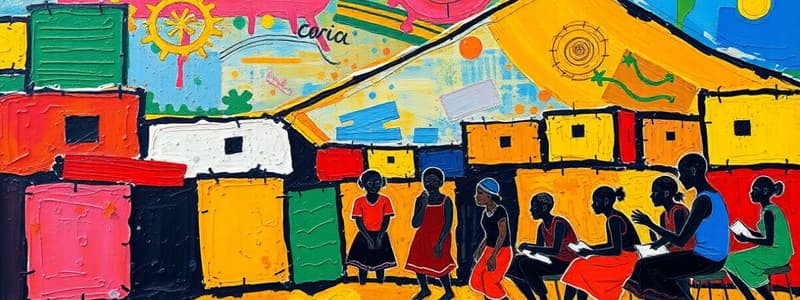Podcast
Questions and Answers
What is a significant cause of socio-economic imbalances?
What is a significant cause of socio-economic imbalances?
- Global warming
- Lack of education and skills (correct)
- Weather changes
- Cultural diversity
Education plays a role in fighting inequality and injustice.
Education plays a role in fighting inequality and injustice.
True (A)
Name one urban challenge that contributes to poverty.
Name one urban challenge that contributes to poverty.
Unemployment
One way to address poverty and inequality is by creating __________ job opportunities.
One way to address poverty and inequality is by creating __________ job opportunities.
Match the following aspects of inequality with their descriptions:
Match the following aspects of inequality with their descriptions:
What is the definition of 'Inequality of Income'?
What is the definition of 'Inequality of Income'?
The Poverty Line is defined as the maximum income required to meet basic needs.
The Poverty Line is defined as the maximum income required to meet basic needs.
What challenges do individuals face when caught in the Poverty Cycle?
What challenges do individuals face when caught in the Poverty Cycle?
People with incomes below the ___________ cannot meet their basic needs.
People with incomes below the ___________ cannot meet their basic needs.
Match the following terms with their definitions:
Match the following terms with their definitions:
What was the primary goal of apartheid in South Africa?
What was the primary goal of apartheid in South Africa?
All racial groups in South Africa had equal access to land ownership during apartheid.
All racial groups in South Africa had equal access to land ownership during apartheid.
What were Bantustans?
What were Bantustans?
The Land Act restricted Black people to owning only ______% of the land despite making up over 75% of the population.
The Land Act restricted Black people to owning only ______% of the land despite making up over 75% of the population.
Match the following laws with their effects:
Match the following laws with their effects:
Which of the following rights were NOT granted to Black, coloured, or Indian people during apartheid?
Which of the following rights were NOT granted to Black, coloured, or Indian people during apartheid?
The socio-economic imbalances in South Africa have been completely resolved since the end of apartheid.
The socio-economic imbalances in South Africa have been completely resolved since the end of apartheid.
What was one consequence of the economic policies during apartheid?
What was one consequence of the economic policies during apartheid?
Flashcards
Economic Inequality
Economic Inequality
When some people have more resources (like money or opportunities) than others.
Inequality of Income
Inequality of Income
When some people earn a lot of money, while others earn little or nothing.
Inequality of Opportunity
Inequality of Opportunity
When some people have access to better education, jobs, or resources than others.
Poverty
Poverty
Signup and view all the flashcards
Poverty Line
Poverty Line
Signup and view all the flashcards
Poverty Cycle
Poverty Cycle
Signup and view all the flashcards
Inequality
Inequality
Signup and view all the flashcards
Poverty
Poverty
Signup and view all the flashcards
Socio-economic imbalances
Socio-economic imbalances
Signup and view all the flashcards
South Africa's inequality
South Africa's inequality
Signup and view all the flashcards
Education and skills
Education and skills
Signup and view all the flashcards
Urban challenges
Urban challenges
Signup and view all the flashcards
Rural challenges
Rural challenges
Signup and view all the flashcards
Poverty alleviation programs
Poverty alleviation programs
Signup and view all the flashcards
Sustainable job opportunities
Sustainable job opportunities
Signup and view all the flashcards
Apartheid
Apartheid
Signup and view all the flashcards
White Privilege
White Privilege
Signup and view all the flashcards
Racial Discrimination
Racial Discrimination
Signup and view all the flashcards
Land Act
Land Act
Signup and view all the flashcards
Group Areas Act
Group Areas Act
Signup and view all the flashcards
Homelands/Bantustans
Homelands/Bantustans
Signup and view all the flashcards
Socio-economic Imbalances
Socio-economic Imbalances
Signup and view all the flashcards
Study Notes
Poverty and Inequality
- This module focuses on understanding inequality and poverty, examining the causes of socio-economic imbalances in South Africa, the need for education and skills to fight inequality, and examining programs to address poverty and inequality.
- By the end of this module, students should be able to explain what inequality and poverty are, explain the causes of socio-economic imbalances, describe inequality in South Africa, explain how education and skills can be used to fight inequality, explain what urban and rural challenges are around poverty and inequality, and describe programmes that address poverty and inequality.
- In module 2, resources such as money are limited. People struggle to meet basic needs, while others have more than enough. This module will specifically look at the inequality in South Africa, education, and skills to fight inequality and injustice. It will also focus on finding out what sustainable job opportunities are and how they can be created.
Studying That Suits You
Use AI to generate personalized quizzes and flashcards to suit your learning preferences.




